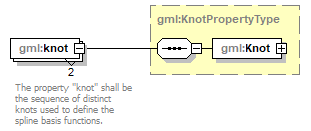| diagram |  |
||||||||||||||||||||||||||||||||||||||||||||||||||||||
| namespace | http://www.opengis.net/gml | ||||||||||||||||||||||||||||||||||||||||||||||||||||||
| type | restriction of gml:BSplineType | ||||||||||||||||||||||||||||||||||||||||||||||||||||||
| properties |
|
||||||||||||||||||||||||||||||||||||||||||||||||||||||
| children | gml:pos gml:pointProperty gml:pointRep gml:posList gml:coordinates gml:degree gml:knot | ||||||||||||||||||||||||||||||||||||||||||||||||||||||
| used by |
|
||||||||||||||||||||||||||||||||||||||||||||||||||||||
| attributes |
|
||||||||||||||||||||||||||||||||||||||||||||||||||||||
| annotation |
|
||||||||||||||||||||||||||||||||||||||||||||||||||||||
| source | <xs:complexType name="BezierType"> <xs:annotation> <xs:documentation>Bezier curves are polynomial splines that use Bezier or Bernstein polynomials for interpolation purposes. It is a special case of the B-Spline curve with two knots.</xs:documentation> </xs:annotation> <xs:complexContent> <xs:restriction base="gml:BSplineType"> <xs:sequence> <xs:choice> <xs:annotation> <xs:documentation>GML supports two different ways to specify the control points of a curve segment. 1. A sequence of "pos" (DirectPositionType) or "pointProperty" (PointPropertyType) elements. "pos" elements are control points that are only part of this curve segment, "pointProperty" elements contain a point that may be referenced from other geometry elements or reference another point defined outside of this curve segment (reuse of existing points). 2. The "posList" element allows for a compact way to specifiy the coordinates of the control points, if all control points are in the same coordinate reference systems and belong to this curve segment only.</xs:documentation> </xs:annotation> <xs:choice minOccurs="0" maxOccurs="unbounded"> <xs:element ref="gml:pos"/> <xs:element ref="gml:pointProperty"/> <xs:element ref="gml:pointRep"> <xs:annotation> <xs:documentation>Deprecated with GML version 3.1.0. Use "pointProperty" instead. Included for backwards compatibility with GML 3.0.0.</xs:documentation> </xs:annotation> </xs:element> </xs:choice> <xs:element ref="gml:posList"/> <xs:element ref="gml:coordinates"> <xs:annotation> <xs:documentation>Deprecated with GML version 3.1.0. Use "posList" instead.</xs:documentation> </xs:annotation> </xs:element> </xs:choice> <xs:element name="degree" type="nonNegativeInteger"> <xs:annotation> <xs:documentation>The attribute "degree" shall be the degree of the polynomial used for interpolation in this spline.</xs:documentation> </xs:annotation> </xs:element> <xs:element name="knot" type="gml:KnotPropertyType" minOccurs="2" maxOccurs="2"> <xs:annotation> <xs:documentation>The property "knot" shall be the sequence of distinct knots used to define the spline basis functions.</xs:documentation> </xs:annotation> </xs:element> </xs:sequence> <xs:attribute name="interpolation" type="gml:CurveInterpolationType" fixed="polynomialSpline"> <xs:annotation> <xs:documentation>The attribute "interpolation" specifies the curve interpolation mechanism used for this segment. This mechanism uses the control points and control parameters to determine the position of this curve segment. For a Bezier the interpolation is fixed as "polynomialSpline".</xs:documentation> </xs:annotation> </xs:attribute> <xs:attribute name="isPolynomial" type="boolean" fixed="true"> <xs:annotation> <xs:documentation>The attribute isPolynomial is set to true as this is a polynomial spline.</xs:documentation> </xs:annotation> </xs:attribute> <xs:attribute name="knotType" type="gml:KnotTypesType" use="prohibited"> <xs:annotation> <xs:documentation>The property "knotType" is not relevant for Bezier curve segments.</xs:documentation> </xs:annotation> </xs:attribute> </xs:restriction> </xs:complexContent> </xs:complexType> |
attribute BezierType/@interpolation
| type | gml:CurveInterpolationType | ||||||||||||||||||||||||||||||||||||
| properties |
|
||||||||||||||||||||||||||||||||||||
| facets |
|
||||||||||||||||||||||||||||||||||||
| annotation |
|
||||||||||||||||||||||||||||||||||||
| source | <xs:attribute name="interpolation" type="gml:CurveInterpolationType" fixed="polynomialSpline"> <xs:annotation> <xs:documentation>The attribute "interpolation" specifies the curve interpolation mechanism used for this segment. This mechanism uses the control points and control parameters to determine the position of this curve segment. For a Bezier the interpolation is fixed as "polynomialSpline".</xs:documentation> </xs:annotation> </xs:attribute> |
attribute BezierType/@isPolynomial
| type | xs:boolean | ||||
| properties |
|
||||
| annotation |
|
||||
| source | <xs:attribute name="isPolynomial" type="boolean" fixed="true"> <xs:annotation> <xs:documentation>The attribute isPolynomial is set to true as this is a polynomial spline.</xs:documentation> </xs:annotation> </xs:attribute> |
attribute BezierType/@knotType
| type | gml:KnotTypesType | ||||||||||||
| properties |
|
||||||||||||
| facets |
|
||||||||||||
| annotation |
|
||||||||||||
| source | <xs:attribute name="knotType" type="gml:KnotTypesType" use="prohibited"> <xs:annotation> <xs:documentation>The property "knotType" is not relevant for Bezier curve segments.</xs:documentation> </xs:annotation> </xs:attribute> |
element BezierType/degree
| diagram |  |
||||
| namespace | http://www.opengis.net/gml | ||||
| type | xs:nonNegativeInteger | ||||
| properties |
|
||||
| annotation |
|
||||
| source | <xs:element name="degree" type="nonNegativeInteger"> <xs:annotation> <xs:documentation>The attribute "degree" shall be the degree of the polynomial used for interpolation in this spline.</xs:documentation> </xs:annotation> </xs:element> |
element BezierType/knot
| diagram |  |
||||||||
| namespace | http://www.opengis.net/gml | ||||||||
| type | gml:KnotPropertyType | ||||||||
| properties |
|
||||||||
| children | gml:Knot | ||||||||
| annotation |
|
||||||||
| source | <xs:element name="knot" type="gml:KnotPropertyType" minOccurs="2" maxOccurs="2"> <xs:annotation> <xs:documentation>The property "knot" shall be the sequence of distinct knots used to define the spline basis functions.</xs:documentation> </xs:annotation> </xs:element> |
XML Schema documentation generated by XMLSpy Schema Editor http://www.altova.com/xmlspy